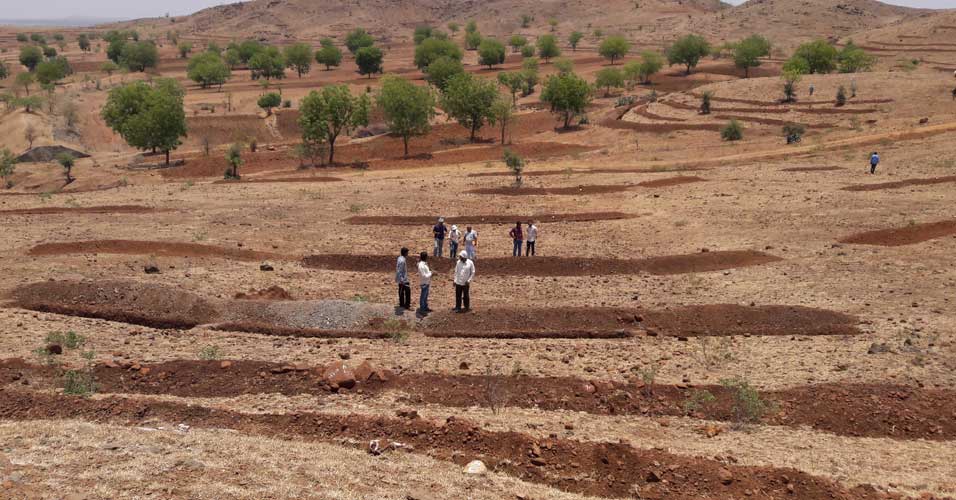Armed with plastic buckets and mud pots, a heavily pregnant lady, ‘Aarti Meshram’ along with her nine-year-old daughter and six-year-old son trudge nearly two kilometres in the searing Vidarbha heat to join an endless queue of humanity for the ‘elixir of life’ – water being supplied through tankers.
While Aarti required complete bed rest considering her medical condition, her children had to be in school so that they could rise up the social ladder aided by education. However, each day nearly five hours are spent doing multiple treks in search of the lifesaving water tanker and standing patiently in scorching conditions awaiting their turn hopefully before the tanker is emptied.
This is the scene across parched Vidarbha wherein thousands are dependent on the hundreds of water tankers – both private and deployed by governmental agencies. Some estimates show that certain dams in Vidarbha are at near empty levels and monsoons being lacklustre this year as well.
Water shortage and availability is an alarming and critical problem facing a large number of Indians. In addition, climate change is infuriating this problem. Water use has been growing at more than twice the rate of population increase in the last century. In fact, it is predicted that future wars will not be fought over control of land or ideology but access to water.
Within last 60 years, India’s average annual per capita availability of water taking into consideration the population in various census has reduced nearly 70 percent from 1951 to 2011. The per capita availability of water as per 1951 census was 5177 cubic meters. This has reduced to 1545 cubic meters as per 2011 census.
As the country is extremely dependent on the monsoon rains, it will have to address a difficult and chaotic future arising out of severe water tension. Climatic variations are already affecting the duration, timing, and intensity of rainfall which is leading to drought across large parts of India.
Water was irrationally considered to be limitless but now that the reality has dawned upon one and all – it is necessary to take corrective measures at the earliest. It is herein that the corporate sector could make a significant contribution towards reducing water stress.
With 10.76 lakh actively registered companies’ nationwide and significant number amongst them mid to large-sized, it could emerge a harbinger of change. In addition, all companies are mandated by law to put in two percent of profits into CSR activities which could be channelized into water-related projects.
In fact, many companies are beginning to realise that water stewardship should become one of the key areas of CSR. Nearly every business depends largely on the availability of fresh water and it is in the interest of the stakeholders – including companies to ensure that water resources are better protected.
For companies, the efficient management of water is an even more arduous task vis-à-vis competent carbon management. The main risks for a company refer to its ability to have sufficient provisions for clean water in the future to sustain its business. Water is far more complex than carbon and deserves greater endeavour than merely transferring carbon metrics into our most intricate natural resource. Hence, it is imperative that companies have a Net positive impact (NPI) – which means business impacts on the environment and society need to be positive, to the point that they outweigh the negative impacts.
Towards this endeavour, companies need to take more initiatives to decrease their water consumption. NPI, when applied to water, means giving back more water than utilised in the manufacturing process.
The question is, does it stand up to analysis when we think about water?
With water, we have to mull over various things like seasonality, rainfall etc. How do we become water positive when we often find ourselves in a drought or flood? Questions like does the water you “put back” into the structure go in at the same time of year you took it out? Companies need to build up a strategy around commercial water risk management and what ‘sustainable water use’ might look like.
In order to make constructive inroads in water and business challenges, there is a need for companies to explore the management, social values, and policy regimes that govern water. Once the standards and rules are in place, it will help to mobilize resources.
For water, sustainability practices have to be significant to people excluding just the business – because of the challenges that in actuality matter are not internal anymore.
 Dr. Vikas Goswami heads the Sustainability function at Godrej Industries Limited and Associated companies.
Dr. Vikas Goswami heads the Sustainability function at Godrej Industries Limited and Associated companies.
In her current role, Vikas drives the Group’s ‘Good & Green’ vision of creating a more employable workforce, building a Greener India and innovating for good and green products. Under her leadership, the team is laying down processes to evaluate the impact of the Group’s Good & Green initiatives.
Views of the author are personal and do not necessarily represent the website’s views.
Thank you for reading the story until the very end. We appreciate the time you have given us. In addition, your thoughts and inputs will genuinely make a difference to us. Please do drop in a line and help us do better.
Regards,
The CSR Journal Team


